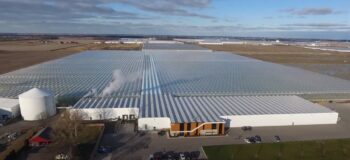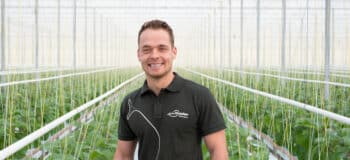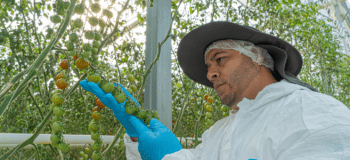Population growth is a global question, especially in countries where densely populated megacities are on the rise. Take China for example; a country where topics like food-security and the availability of fossil fuels are high on the agenda. Will building Dutch greenhouses simply solve these issues, or is a different approach required?
To find out, a group of Dutch horticultural suppliers and research bodies founded the Dutch Sino Horti Cooperation. In 2013 they kicked off their ‘Partners for International Business’ (PIB) consortium in order to find out how to help the Chinese horticulture with adaptive Dutch technologu and know-how. It resulted in the opening of a Chinese Solar Greenhouse at the Research location of Wageningen University in Bleiswijk, The Netherlands. The greenhouse has been used to better adapt the Dutch solutions and practices to Chinese standards, level of knowledge and habits.
Presenting results
After more than a year of trials with Dutch horticulture solutions in a Chinese setting, the findings of the research were highlighted during a special seminar that was organized in Beijing last week. The event was opened by Ridder sales manager and seminar-chairman Joachim Keus. He explained that the future success of horticulture development in China will be determined by more factors than just offering a tailored greenhouse design or adaptive solution. “Aside of providing our technology, we need to share our knowledge and increase partnerships with Chinese government, businesses and research institutes”, ten Haaf said.
Golden Triangle
The PIB consortium is a good example of the opportunities that these partnerships create. “In this consortium we have been working together with other companies, researchers and governments. We have shown that cooperation between countries like Holland and China, but also between government, researchers and business, the so-called Golden Triangle, is very important. It’s all about bearing challenges and solving issues together.”
Agrofood development
Various Vietnamese investors are showing interest in injecting their capital into the resurgent domestic agriculture and horticulture sector. There is much demand for agricultural products and some big industrial heavyweights see a chance to invest in the horticulture chain. These developments are associated with the necessary contributions from Vietnam’s export partners. Although the Vietnamese government designated the Netherlands as a preferred partner for agrofood development, many Japanese and Korean partners are also involved in projects. These countries are interested in Vietnam’s export potential and realise that further technological development of the Vietnamese horticulture sector is needed.
Asia’s market garden
Jan Hoogewoning, Business Development Manager for Southeast Asia at Ridder, is following the developments in Vietnam closely. He notes that much more knowledge and support will be needed to help the local horticulture sector get going. “Vietnam, and particularly the higher altitude southern region round Da Lat, have everything that’s needed to become the primary horticulture area in Southeast Asia. There is a favourable climate for greenhouse cultivation and also an increasing demand for safe and year-round cultivated products. However, many growers are not yet capable of raising a high-quality, uniform and food-safe product. They lack the right technological resources, and also frequently the knowledge and insight to invest in these. Often they don’t know all the possibilities. ”

For the coming years, the solar greenhouse concept and Chinese horticulture be inseparable. We therefore need to continue to integrate and adapt our solutions to Chinese standards.
Sustainable horticulture
According to Ten Haaf, the successful transformation towards sustainable horticulture in China lies in the adaptation of technologies that will enable Chinese growers to minimize the dependency on fossil fuels, freshwater, fertilizers and labour. “China is home to a huge horticulture industry with more than 1,5 million hectares of solar greenhouses. To gain the efficiency of these operations and future-proof the greenhouse industry we should not only introduce technologies such as hydroponics, irrigation control, sensoring, ventilation or screening, but also show Chinese industry that we understand and can help solve their local needs and challenges.”
Modernise
The latter was exactly the scope of the Solar Greenhouse Project at Wageningen’s greenhouse research campus in The Netherlands. The PIB consortium has therefore decided to extend the trial with two more years of research. “The solar greenhouse concept and Chinese horticulture will for the coming years be inseparable. On one hand we therefore need to continue to integrate and adapt our solutions to Chinese standards and make sustainable horticulture more accessible. On the other hand, we will also need to look at modernizing the industry with more high-tech solutions and the development of profitable agro-parks. Again, the success of such developments will also be greatly determined by important factors such as knowledge exchange and partnerships with universities, investors, businesses and government. We have to work together.”





